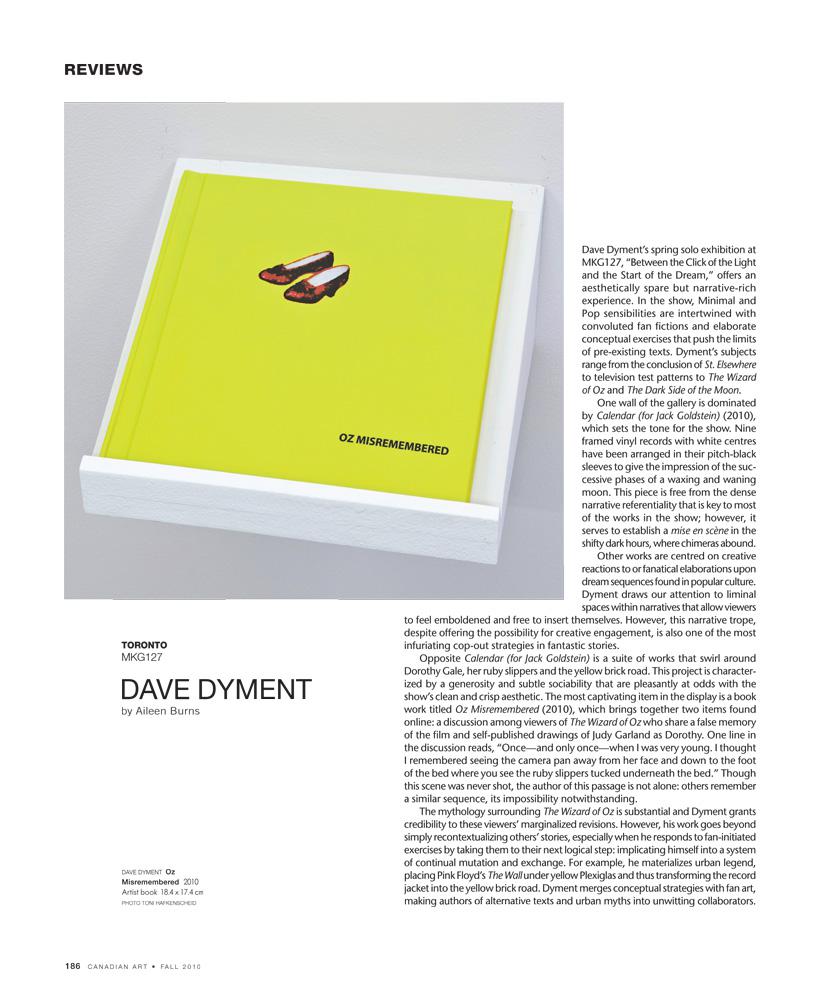Dave Dyment’s spring solo exhibition at MKG127, “Between the Click of the Light and the Start of the Dream,” offers an aesthetically spare but narrative-rich experience. In the show, Minimal and Pop sensibilities are intertwined with convoluted fan fictions and elaborate conceptual exercises that push the limits of pre-existing texts. Dyment’s subjects range from the conclusion of St. Elsewhere to television test patterns to The Wizard of Oz and The Dark Side of the Moon.
One wall of the gallery is dominated by Calendar (for Jack Goldstein) (2010), which sets the tone for the show. Nine framed vinyl records with white centres have been arranged in their pitch-black sleeves to give the impression of the successive phases of a waxing and waning moon. This piece is free from the dense narrative referentiality that is key to most of the works in the show; however, it serves to establish a mise en scène in the shifty dark hours, where chimeras abound.
Other works are centred on creative reactions to or fanatical elaborations upon dream sequences found in popular culture. Dyment draws our attention to liminal spaces within narratives that allow viewers to feel emboldened and free to insert themselves. However, this narrative trope, despite offering the possibility for creative engagement, is also one of the most infuriating cop-out strategies in fantastic stories.
Opposite Calendar (for Jack Goldstein) is a suite of works that swirl around Dorothy Gale, her ruby slippers and the yellow brick road. This project is characterized by a generosity and subtle sociability that are pleasantly at odds with the show’s clean and crisp aesthetic. The most captivating item in the display is a book work titled Oz Misremembered (2010), which brings together two items found online: a discussion among viewers of The Wizard of Oz who share a false memory of the film and self-published drawings of Judy Garland as Dorothy. One line in the discussion reads, “Once—and only once—when I was very young. I thought I remembered seeing the camera pan away from her face and down to the foot of the bed where you see the ruby slippers tucked underneath the bed.” Though this scene was never shot, the author of this passage is not alone: others remember a similar sequence, its impossibility notwithstanding.
The mythology surrounding The Wizard of Oz is substantial and Dyment grants credibility to these viewers’ marginalized revisions. However, his work goes beyond simply recontextualizing others’ stories, especially when he responds to fan-initiated exercises by taking them to their next logical step: implicating himself into a system of continual mutation and exchange. For example, he materializes urban legend, placing Pink Floyd’s The Wall under yellow Plexiglas and thus transforming the record jacket into the yellow brick road. Dyment merges conceptual strategies with fan art, making authors of alternative texts and urban myths into unwitting collaborators.
This is an article from the Fall 2010 issue of Canadian Art. To read more from this issue, please visit its table of contents.

 Spread from the Fall 2010 issue of Canadian Art
Spread from the Fall 2010 issue of Canadian Art







